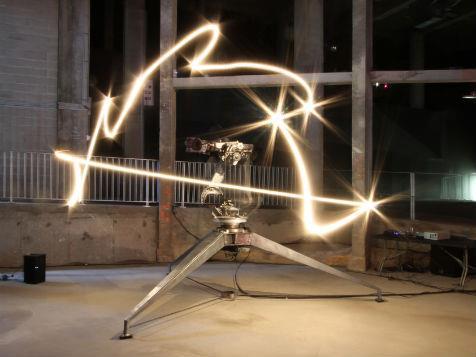Image: Conrad Shawcross, ‘ADA’, Museum of Old and New Art
A number of artists will cross multiple genres in a bid to create immersive, meaningful and unique arts experiences for MOFO punters. Lights, musical improvisation, animation, and dancing robots are just some of the elements that will collide in the five-day arts festival, soon to be enjoying its sixth year of creativity.
MONA FOMA is the Museum of Old and New Art’s Festival of Music and Art, also fondly known as MOFO, which happens annually in Hobart each January. Its 2014 program has once more been curated by Brian Ritchie, along with senior curators Nicole Durling and Olivier Varenne.
Ritchie first gained widespread recognition as bassist for Violent Femmes before moving on to other musical challenges such as the shakuhachi; a Japanese bamboo flute. ‘I now consider myself more a shakuhachi player than anything else, because that’s what I work on the most. Eventually I see myself just playing shakuhachi in a temple and not much else,’ said Ritchie.
Driven by the goal of finding balance within his musical practice, Ritchie explores a wide spread of genres including jazz, blues and classical in his music. He has also moved beyond sound and improvised with contemporary and Butoh dancers. According to Ritchie, ‘People love to dance to music but this is a different expression. I love having a dancer in the band because it leads your musical improvisations to areas notes can’t go.’
This explorative attitude has led to musical collaborations with visual artists, such as sculptors and animators, and has come to inform his current practice. Ritchie is presently on tour in China, improvising live to an animation by Zeng Yi Gang with Michael Kieran Harvey on piano, Xie Yu Dan on pipa, and Ma Jia Jun on erhu.
While Ritchie is enthusiastic about hybrid arts experimentation, he believes that to be successful it must be conceived and executed with a balanced and considered approach. According to Ritchie, ‘The challenge to cross-media collaborations for the artists is to find a common language and to identify the areas of symbiosis. You want the various art forms to reinforce each other, not distract from each other.’
This interest in the merging of art forms has flowed through to the MONA FOMA festival program. ‘We have some tremendous cross-pollinations in MOFO 2014,’ said Ritchie.
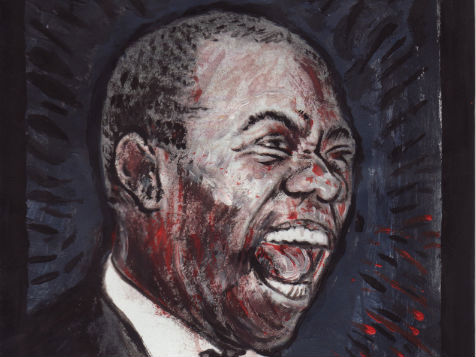
Image: Australian Art Orchestra (cropped), Museum of Old and New Art
One notable work is Struttin’ With Some BBQ by the Australian Art Orchestra (AAO), a commission exploring the life and artistry of Louis Armstrong. ‘Besides jazz and improvised music from the band, there are two visual artists. Linzee Arnold, a pioneering graphic novelist from Tasmania and jazz buff, and Sabina Maselli who will be doing projections, stage set and film. Plus poetry recitation from Allan Browne, who also plays in the AAO using an authentic period drum kit,’ said Ritchie.
This out-of-the-box approach is nothing new for the AAO, a leading contemporary music ensemble founded by pianist and composer Paul Grabowsky in 1994. With Peter Knight as Artistic Director, the AAO are known for stretching genres through multi-disciplined work and collaborations.
Struttin’ With Some BBQ, composed by Eugene Ball and featuring special guest folk/soul singer songwriter Ngaiire, will be performed on Wednesday 15 January, from 6pm, at the Theatre Royal, Hobart. Tickets are $35 to $65.
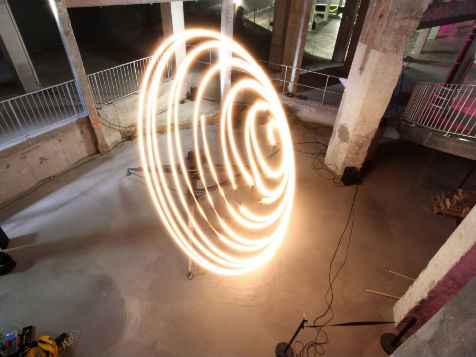
Image: Conrad Shawcross, ‘ADA’, Museum of Old and New Art
British artist Conrad Shawcross will also be jumping across art forms by combining a dancing industrial robot with live and recorded sound in The ADA Project. The artist has made a name for himself by creating mechanical sculptures that explore questions of science and philosophy to highlight abstract scientific thinking. The ADA Project, a choreographed light sculpture, was inspired by mathematician and daughter of Lord Byron, Ada Lovelace, who foresaw the development of computer-generated music.
Contemporary performers will interact with the robot in four collaborative performances. These include singer-songwriter Tamara Barnett-Herrin and electronic producer Mylo, Warp Records musician Mira Calix and soprano Teresa Duddy, and composers Beatrice Dillon and Rupert Clervaux. There will also be a virtual performance by electronic musician Holly Herndon.
The ADA Project performances will unfold at MAC1, Hobart on Thursday 16 Jan and Friday 17 January at 6pm, Saturday 18 January at 4pm, and Sunday 19 January at 4pm and 8pm. Although price is included in the MONA FOMA festival ticket there is limited capacity for each show.
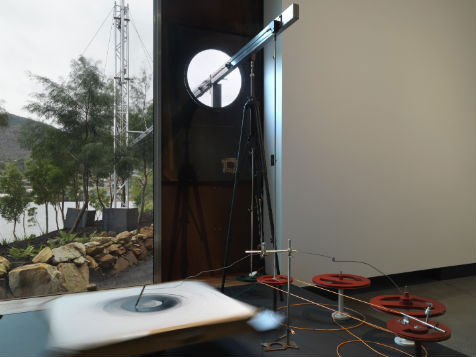
Image: ‘Wind Section – Instrumental’, 2013, Museum of Old and New Art
Machines continue to break down genres throughout the festival, this time with the help of Australian artist Cameron Robbins, who creates mechanical work that illustrates invisible patterns of the natural world. Robbins’ Wind Section – Instrumental is currently being displayed at MONA as part of The Red Queen, an exhibition that investigates the impulses of art making through a broad selection of artworks.
With support from the Australia Council, Wind Section – Instrumental will be renamed Sonic Wind Section for its stint at MONA FOMA, and expanded to include performances from improvising musicians and artists such as Peter Knight from the AAO, Jon Tarry, Robbins himself, and many others. Performances will run from Friday 17 January to Sunday 19 January from 10am to 6pm at MONA. Price is included in the museum entry.

Image: Tyondai Braxton: HIVE, Museum of Old and New Art
Another cross-arts endeavour, and one guaranteed to draw a large crowd, is the multimedia project HIVE, created by New York composer, performer and founder of avant-rock group Battles, Tyondai Braxton. Large-scale installation will combine with sound design, modular synthesis, and acoustic instrumentation to create the effect of a lit-up oval ‘hive’ that emanates layered percussive sound loops in unpredictable patterns.
Braxton commissioned Danish architect and carpenter Uffe Surland Van Tams to create the ‘hive’ space of five giant wooden platforms. Braxton and Ben Vida from PAN Records, along with percussionists Yuri Yamashita, Chris Thompson and Matt Smallcomb will perform on top of these pod-like spaces. Originally performed at the Guggenheim Museum in 2012, HIVE can be experienced by Australian audiences on Friday 17 January, 8:30pm and 10:45pm, at MAC2 Backspace, with the price included in the MONA FOMA festival ticket.
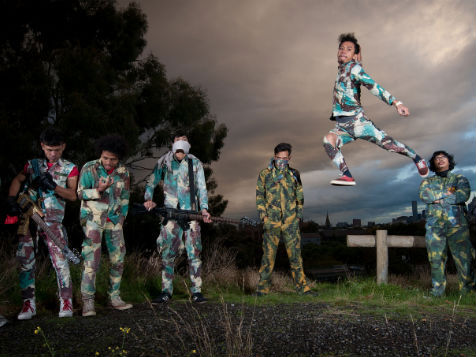
Image: Slave Pianos and Punkasila (cropped), Museum of Old and New Art
Playing with cross-cultural hybridity is The Lepidopters, a collaboration between two art collectives from Melbourne, Australia and Yogyakarta, Indonesia. The improvisational production tells the outrageous story of an alien moth invasion in the Indonesian archipelago with the aim of total Earth colonisation through inter-species reproduction. Gamelan instruments and comic-book style projections will feature throughout the work.
Slave Pianos and Punkasila’s The Lepidopters was funded by the Australia Council, and includes pianist Michael Kieran Harvey and vocalist Rachel Saraswati. It will be performed on Thursday 16 January, 7:15pm and 9:15pm, at MAC2 Backspace, Hobart. Price is included in a MONA FOMA festival ticket.
These events are a small selection from MONA FOMA’s 2014 program, which is filled with a multitude of genre-defying events. While this expansive approach is highly challenging for the artists, Ritchie believes that it provides multiple access points for audiences and allows for easier engagement. This in turn increases the appetite for experimentalism and innovation. ‘For example, live soundtracks to silent films allow the musicians to play much more abstract and bizarre music than most audiences would want to listen to on its own, without the film,’ said Ritchie.
This inclusive approach seems well suited to a festival that refuses to be tied down to specific themes. In terms of MONA FOMA’S curatorial direction Ritchie said, ‘We prefer to let the audience observe and connect the dots themselves.’ This attitude mixed with its 2014 openness to hybridity has once again confirmed MONA FOMA as Australia’s most surprising and unique music and arts festival.
MONA FOMA will run from 15-19 January 2014 at various locations around Hobart. The full program is available on the MONA FOMA website. Tickets are on sale now.
